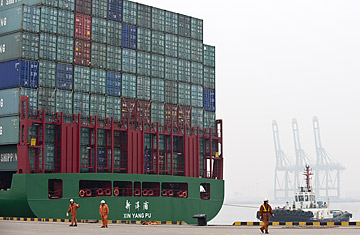
A cargo ship laden with containers stands in the port at Tianjin China.
China's economy expanded 6.1% on annualized basis in the first quarter, its slowest pace since 1998. Singapore's GDP contracted an astounding 19.7% in the same period — after shrinking 16.4% in the previous quarter. Hong Kong has yet to report first-quarter numbers, but its economic performance in the final quarter 2008 does not inspire confidence: GDP growth was minus 2.5%. In the same period, the South Korean economy contracted 5.6% while Japan, Asia's largest economy and the world's second biggest, shrank 12.7%.
You wouldn't know it from the stock markets, though. Three weeks into April, the MSCI Pacific Index, which includes Australia and Japan, is up 10.4% for the month, and 3% over three months. The MSCI Australia Index has risen 6.6% month-to-date, the Hong Kong index 15%, and Japan 11%. Even hapless Singapore is doing well, thank you very much, boasting gains of 11.7% in the month to April 20 and 7.6% over three months.Read "China Takes On the Global Car Business.")
Asia's emerging markets are doing even better. The MSCI EM Asia Index is higher by 22.5% over three months, led by Pakistan (72.4%), Indonesia (36.9%), Taiwan (33.3%) and China (25%). Korea, which for some reason MSCI still classifies as an emerging market even though the country is a member of the OECD, is up 18.4%. India? Higher by 15.6%. The Philippines is up 13%, Malaysia 9.2% . . . you get the picture.
The old saw is that the markets anticipate GDP health six months or so in advance, so what this disconnect is telling us is that economic recovery is just around the corner. Sure, we're seeing some green shoots particularly in China, where industrial production rose 8.3% year-on-year in March, retail sales surged 15.9% in the first quarter, and investment in fixed assets jumped 28.6% in March after rising 26.5% in February. But it's difficult to see how Asia can return to real growth with export demand dead in the U.S. and Europe — and no one expects a resurrection there anytime soon.
It may be that China's communist rulers, fearful of social unrest that can force them from power, will succeed in buying their way to their target of 8% GDP growth, the magic number that will supposedly ensure that enough of the 1.3 billion population will have jobs. The central government has already started spending $585 billion in fiscal stimulus, second in size only to America's $787 billion (and counting) package. A second stimulus package valued at 130 billion renminbi ($19 billion) is expected to be unveiled soon.
No stranger to deficit spending, Japan approved this month a new Policy Package to Address the Economic Crisis worth $156 billion, its third fiscal stimulus package since September — and the umpteenth attempt to jumpstart the economy since the bursting of the asset bubble way back in the 1990s. None of the previous attempts worked, in part because much of the money went to wasteful public works spending in the bailiwicks of ruling-party politicians. The latest spending appears to make more economic sense, targeting job-creation, support for the equity market, increased transfers to regional governments, health-care spending, and energy efficiency.
The question is whether the region's gobs of easy money will actually go where it is supposed to go. It's all too easy for the state's largesse to end up in the pockets of politicians and other vested interests. The other issue is the long-term damage to economies from the sheer size of the deficit spending. The Chinese spending is equivalent to nearly 13% of GDP while that in Japan comes to 5%. Australia's fiscal stimulus equals 5% of GDP too, while Korea's is at 3.7%, Taiwan's at 3.4% and Thailand's at 2.8%.
What does all this mean to personal investors? Be cautious, and don't chase dazzling performance numbers. Economic recovery may indeed arrive early in China, or at least before it appears in the US. But government stimulus does not naturally translate into sustained private investment, so there will likely be nasty hiccups along the way. So far, at least, most Asian stock markets seem to be blissfully unaware of that risk.
